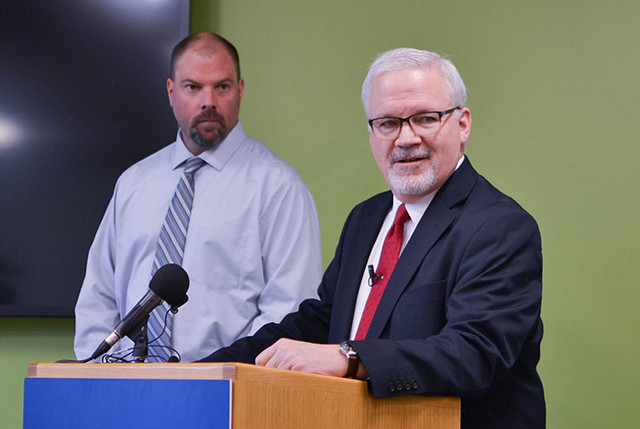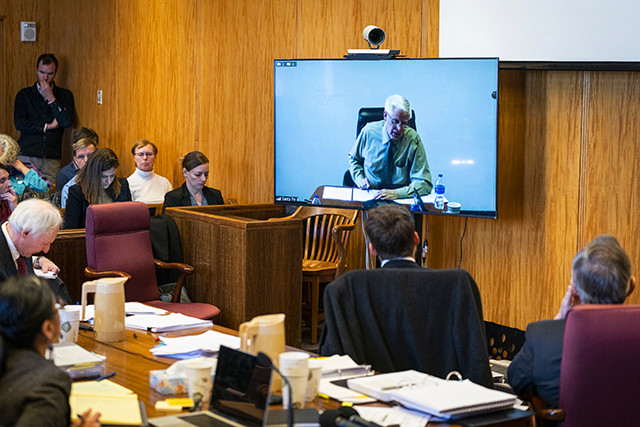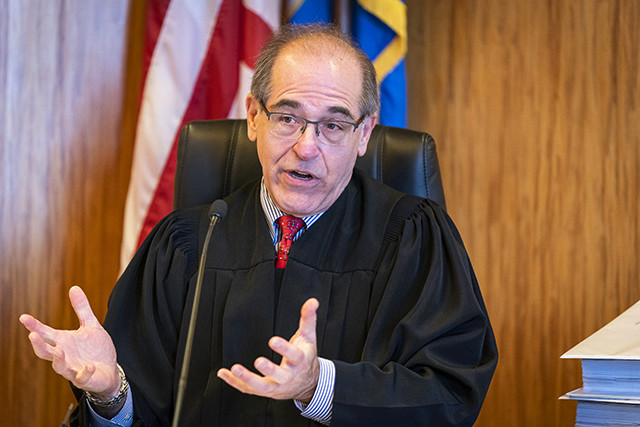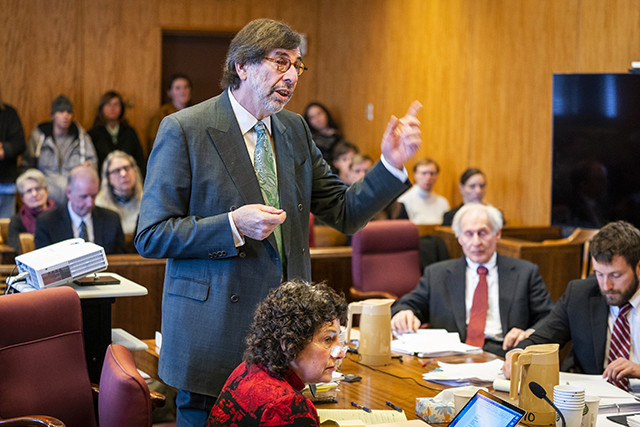
By Walker Orenstein, MinnPost, through the Institute for Nonprofit News network
In March of 2018, staff at the Minnesota Pollution Control Agency were slammed.
The regulators were answering a rush of comments on a draft water pollution permit for a copper-nickel mine owned by PolyMet Mining. And with only days left before the comment period ended, the U.S. Environmental Protection Agency was planning to submit its own critiques of the controversial project.
So John Linc Stine, commissioner of the MPCA at the time, called the EPA with an unusual, if not unprecedented, request: Would they delay commenting along with the public and save their concerns for later?
“The staff were really deluged by the response requirements of responding to hundreds of public comments,” Stine said.
Despite Stine’s explanation, that plea is now at the heart of a legal fight in district court over whether the MPCA was actually trying to bend rules to hide the EPA’s criticisms from the public. A coalition of environmental nonprofits and the Fond du Lac Band of Lake Superior Chippewa sued the MPCA last year and have accused the state of breaking with regular procedure and deleting records to cover its tracks.
As Stine and other current and former MPCA and EPA officials were interrogated under oath over five days in Ramsey County District Court in the last week, a more complete picture of the episode has emerged, revealing divisions within the federal government, the state’s unconventional handling of the PolyMet permit and the MPCA’s justification for deleting noteworthy emails.
All involved seem to concede the permit process was far from normal. But once testimony concludes, Judge John H. Guthmann will have to decide: Was it improper?
A history of written comments
To start construction on its $1 billion mine, PolyMet needs a swath of permits issued by the state and federal government. All were granted after roughly 15 years of environmental review, though some have since been suspended or reversed by courts.
The permit under scrutiny in District Court — known as a National Pollutant Discharge Elimination System permit (NPDES) — covers the release of polluted water into rivers, lakes, streams and wetlands. It was the final state permit granted to PolyMet when issued in December of 2018.
While the MPCA handles and writes the permit, the EPA reviews it to ensure it doesn’t violate the federal Clean Water Act. The feds can make recommendations for changes and also can veto the final permit.
PolyMet submitted an initial application for the permit in 2016, and proposed an updated one in October of 2017. By January of 2018, a draft version of the permit was released for a 45-day public comment period and two open meetings in northeast Minnesota.
As the permit was being developed, staff for the MPCA and the EPA held regular meetings by phone. But the EPA was also preparing to submit formal written comments to critique the permit. One concern: The type of limits on pollutants like mercury and heavy metals set by the MPCA may not be federally enforceable.
Kevin Pierard, a career EPA official who managed the regional NPDES program for nine years, said it was “standard practice” for the agency to submit such written comments on draft versions of a permit. Of roughly 700 NPDES permits he handled before leaving the EPA and joining New Mexico’s Environment Department, Pierard estimated the feds submitted written comments on more than 500 of them.

Kevin Pierard, who oversaw a key water permit at the U.S. Environmental Protection Agency, is questioned via video. (Pool photo by Leila Navidi/Star Tribune via MinnPost)
Pierard said the EPA liked to comment early in permit development because it’s easier for a state to make changes at that point. Major revisions after a permit public comment period could trigger a second round of public comments, he said.
The EPA typically sent its comments in writing to avoid miscommunication and because states must respond to written comments made during the public notice period. But also so critiques can become part of official records. “If someone were to ask what was EPA’s role, what did EPA do, that’s in the record and you can see that,” Pierard said.
A request for ‘wiggle room’
Between Jan. 31 of 2018 — when PolyMet’s public comment period opened — and March 5, Pierard said the EPA told state regulators they intended to submit written comments. The public comment period ended March 16.
But in early March, Pierard said MPCA staff asked him “if there was any wiggle room” to delay the EPA’s comments. Pierard testified the request was odd. He could not recall ever getting a similar request on a draft NPDES permit.
Afterward, on March 12, Stine called Pierard’s boss, Cathy Stepp. At the time, Stepp was the EPA’s Region 5 director, and had been appointed roughly two months earlier after leading Wisconsin’s Department of Natural Resources under Republican Gov. Scott Walker.
Stine again asked if it was possible for EPA to wait until after the public notice period to offer comments. Stepp said she would take the request “under advisement,” Stine testified, and shortly after an MPCA assistant commissioner followed up.
By Pierard’s account, the MPCA’s Shannon Lotthammer told the federal agency it was “inappropriate for EPA to comment with everyone else” and suggested a public comment in writing would violate a longstanding memorandum from the 1970s that governs how Minnesota and the EPA handle NPDES permits.
In a March 13 email, Lotthammer made the request for a delay in writing, telling Stepp’s chief of staff, Kurt Thiede, the state was concerned with the “timing of EPA comments, not the ability for EPA to comment.” (Lotthammer deleted the email before leaving the agency and joining the state Department of Natural Resources in 2019, but a copy was later leaked by a union representing EPA employees.)
At one point in the exchanges, Pierard said he and other EPA staff talked with Lotthammer by phone. Lotthammer told the EPA their comments would “confuse the public,” duplicate concerns by environmental groups and others, and “create a good deal of press,” Pierard testified. Under oath, Lotthammer denied that fear of news coverage motivated the MPCA, and said the state’s request was made because staff was strained by responding to other public comments.
A controversial phone call
Still, Pierard did not agree with the MPCA. He said press coverage should not dictate his actions, and made clear that he believes EPA comments are more important than critiques from environmental groups, even if they have similar critiques.
But Pierard also testified that Thiede, Stepp’s chief of staff, was torn and trying to find “middle ground” between the MPCA and typical EPA protocol. At the time, Thiede had been at the EPA little more than a month. He had previously worked for Stepp at the Wisconsin DNR, but he replaced Stepp as EPA Region 5 director last week.
Shortly before PolyMet’s public comment period closed, Pierard had completed a formal letter of critiques, but he said EPA leadership decided not to send it.
During the hearing last week, Judge Guthmann mostly barred Pierard from testifying about the EPA’s decision since he considered it outside the focus of the hearings. But Paula Maccabee, an attorney for the environmental nonprofit WaterLegacy, argued the comment question was controversial inside the EPA — based on two-dozen emails on the matter between March 14 and 16 that have been redacted by the feds.
The MPCA agreed to prepare a revised draft of the PolyMet permit after it had incorporated changes made in response to public comments. The EPA would have an extra 45 days to review what it called a “pre-proposed permit,” a term made up by the federal agency for the PolyMet NPDES.
Nevertheless, Pierard called MPCA staff on April 12, 2018, to detail his unsent comment letter.
The call has been a major source of controversy since.

Judge John Guthmann presiding over an evidentiary hearing regarding “procedural irregularities’’ in the PolyMet permit case on Jan. 21, 2020. (Pool photo by Leila Navidi/Star Tribune via MinnPost)
Pierard said he read aloud most of the EPA’s comment letter verbatim, “to make sure that (the MPCA) understood exactly what we were saying and what our concerns were and how to rectify that.”
But environmental groups assert notes of the call or EPA’s letter were not put into the administrative record that details how the MPCA made its decision, effectively shielding EPA comments from the public. The administrative record is used during litigation over the permit in the Court of Appeals.
The only MPCA staffer to take notes during the call was attorney Michael Schmidt. Stephanie Handeland, who wrote the permit and compiled its administrative record, said she typically takes notes during such meetings. But she stopped writing two minutes in, tore the page out of her notebook and recycled it because she said Pierard was speaking too fast. Handeland also said the comments were similar to concerns the EPA had raised on earlier calls and she didn’t consider the conversation a “formal comment” by the feds.
As for Schmidt’s notes, Handeland said she didn’t ask for them because she believed they’d be protected by attorney-client privilege. Schmidt also destroyed his notes — after he incorporated them into other legal work the agency says is exempt from disclosure.
MPCA: process unusual, not nefarious
Since the allegations of improper conduct, the MPCA has consistently said it had no nefarious intent when it requested a delay in EPA comments.
While top officials acknowledged some of its actions were unusual, so was the permit, they have testified. PolyMet would be the first copper-nickel mine in Minnesota and has attracted attention, headlines and criticisms for more than a decade. The state rarely sees new mines of any kind, and the permits are complex and time consuming. “There’s not really anything to compare it to for prior projects,” said Jeff Udd, manager of the MPCA’s water and mining section.
MPCA staff said they reviewed comments as they came in, and expected to see a flood of them. Earlier calls with the EPA also led them to believe environmental groups and the Fond du Lac Band would submit comments that overlapped EPA concerns.
So the best and most efficient course of action, agency leaders concluded, was for the EPA to scrutinize a revised draft of the NPDES permit after the state had incorporated the hundreds of comments it received.
Lotthammer, the former assistant commissioner, and Stine, the former commissioner, testified they never intended to say EPA commenting during the public notice period would violate the state’s memorandum with the feds governing NPDES permitting. And they said their request was within the bounds of those rules. “We weren’t trying to suggest not to get comments or be transparent in that,” Lotthammer said. “We were simply requesting that EPA consider allowing us to provide the updated work product before they weighed in with their formal comments.”
Lotthammer also defended her handling of records. While an attorney representing mine opponents, William Pentelovitch, said in court that her March 13 email was the state’s only documentation of the MPCA request for EPA to delay its comments, Lotthammer said she believed it did not qualify as a record she needed to keep under the state’s Data Practice Act and was not necessary to retain in case of litigation. She did not remember consulting anyone before deleting it.

An attorney representing mine opponents, William Pentelovitch, above, said in court that [the MPCA’s Shannon Lotthammer’s] March 13 email was the state’s only documentation of the MPCA request for EPA to delay its comments; Lotthammer said she believed it did not qualify as a record she needed to keep under the state’s Data Practice Act and was not necessary to retain in case of litigation. (Pool photo by Leila Navidi/Star Tribune via MinnPost)
Ultimately, the MPCA says it considered many of the federal concerns when revising its work, and the EPA did not issue written comments on the state’s PolyMet permit or object before it was issued in December 2018. And even Pierard indicated that while his concerns were serious, they were not necessarily big enough to warrant a veto of the permit.
What happens next
Several more witnesses are expected to testify this week at District Court before Judge Guthmann can make a decision in the case. The Court of Appeals asked him to determine whether there were “procedural irregularities,” before transferring the case back to the higher court.
It’s unclear if Guthmann will rule on every unresolved question in the case, but the outcome will influence the litigation in the appeals court over whether the NPDES permit itself is adequate.
One measure of the stakes might be the dozen or so lawyers packed into the wood-paneled courtroom each day between the MPCA, PolyMet, the EPA, environmental groups and the Fond du Lac Band. Guthmann joked it was a meeting of the Bar Association.
While Pierard has left the EPA and Guthmann noted his views may not represent the whole agency, Pierard’s testimony will still likely be the primary window into the EPA’s views on the NPDES permit. And he saw delaying EPA comments for a revised permit as a departure from normal procedure. “That just doesn’t make any sense that we would do that,” he told the court via livestream from Santa Fe, New Mexico. “It’s not our practice and it wouldn’t speed up the process which I think they were concerned about. It actually slows it down.”
This article, first published in MinnPost, is republished here through Great Lakes Now’s membership in the Institute for Nonprofit News, a network of more than 200 nonprofit newsrooms across the U.S., working to strengthen the sources of trusted news for thousands of diverse communities.
MinnPost is a nonprofit, nonpartisan media organization whose mission is to provide high-quality journalism for people who care about Minnesota.
Read some of Great Lakes Now‘s coverage of PolyMet and other mining projects in the region here:
Hearing puts Minnesota agency under scrutiny over PolyMet mine permit
Minnesota court rejects major permits for PolyMet mine
Featured image: John Linc Stine, commissioner of Minnesota’s Pollution Control Agency, speaking to the press on Dec. 20, 2018, after his agency approved environmental permits for the PolyMet copper-nickel mine proposal in northern Minnesota. Jeff Udd is at left. (Photo by Walker Orenstein/MinnPost)




